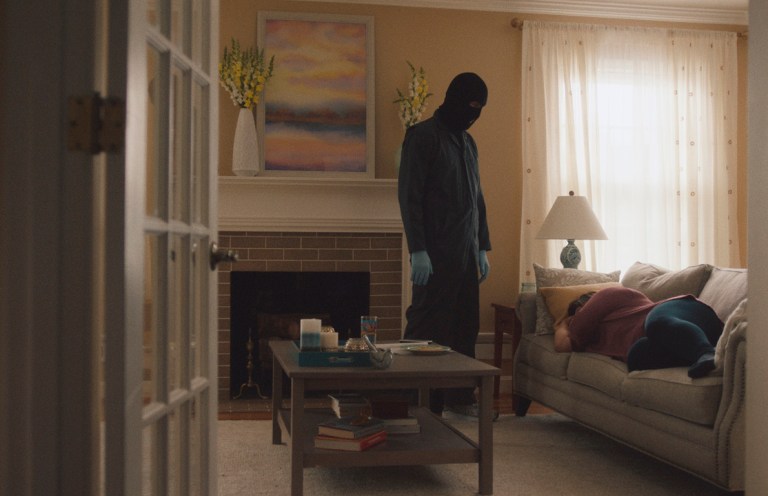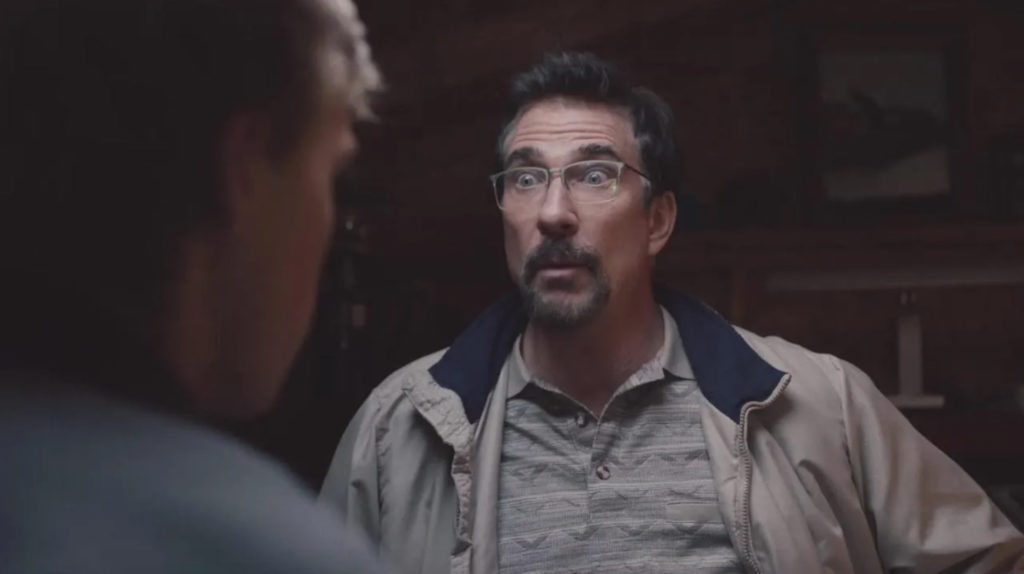‘The Clovehitch Killer’ (2018) Was Inspired by One of the Creepiest Serial Killers of All Time
Some other nicknames BTK gave himself include The Wichita Strangler, The Poetic Strangler, The Asphyxiater, The Garrote Phantom, The Bondage Strangler, and The Wichita Hangman.

The Clovehitch Killer (2018) is a horror thriller about a fictional serial killer nicknamed “the Clovehitch Killer” who once terrorized Kentucky but has not been heard from in over a decade.
The movie follows Tyler Burnside, a 16-year-old boy who lives in a small Kentucky town with his family, a close-knit group of devout Christians. When Tyler finds a photo of a tied-up woman in his father’s truck, at first he is merely shocked to discover that his dad is interested in BDSM, but later he wonders if rough sex is really all that the photo was about. As Tyler’s curiosity grows and he starts to dig into the mystery, he realizes that though his dad’s reputation is that of squeaky-clean Cub Scout leader, he might actually be the dormant killer.
Here’s the trailer:
Obviously, this sounds an awful lot like the Bind Torture Kill strangler, a serial killer named Dennis Rader, a humorless family man, devout Christian, Cub Scout leader, and generally hidden community terrorist from Wichita, Kansas who was responsible for killing at least 10 people.
Director Duncan Skiles came up with the idea of a kid who finds out his father is a serial killer, likely inspired by the real-life story of Kerri Rawson, whose hairbrush was used to confirm DNA evidence that her father was in fact that famed BTK strangler. Kerri wrote a book about her childhood with the man who was sometimes a loving father, devoted Christian, and a community leader and at other times an abusive, unknowable man in A Serial Killer’s Daughter: My Story of Faith, Love, and Overcoming.
Writer Christopher Ford took Duncan’s research into serial killers and the family lives some of them have been able to live and wrote the script. He confirms the obvious — the story is inspired by BTK, but it’s not intended to be a faithful retelling of any real crimes or real killer. In an interview, Ford said, “In the end, the killer in our movie is very much a fictitious invention to serve the deeper character story we wanted to explore. But you’re right to see a few borrowed details from BTK.”
As the movie was never meant to be “about” BTK in particular, it’s obviously not a problem for them to change facts and settings to work with the story they want to tell. However, I think it’s pretty cool when I’m watching a movie to know when there are details that are from a real historical story, so I wanted to make an article talking about which elements from The Clovehitch Killer come from BTK and which are just fictional storytelling elements (or perhaps something from another true-crime case but unrelated to BTK).

Here are elements of the movie that were actually inspired by the real-life BTK:
Both killers gave themselves creepy names. In the movie, the “Clovehitch Killer” names himself after his favorite type of knot. BTK gave himself the nickname BTK in a letter to police. The acronym stands for his Modus Operandi, “Bind them. Torture them. Kill them.” Desperate for validation, BTK wrote many letters to the police, sometimes demanding media attention, saying things such as, “How many people do I have to kill before I get my name in the paper or some national attention?’’ Other nicknames BTK gave himself include The Wichita Strangler, The Poetic Strangler, The Asphyxiater, [sic] The Garrote Phantom, The Bondage Strangler, and The Wichita Hangman.
They subdued their victims with words, not a blitz attack. BTK told Kathryn and Kevin Bright he was on the run from police in California and he only needed money to get to New York. This is a lie told to victims to gain their compliance. Once he tied the two up, he started to strangle Kevin, who managed to escape. His sister, Kathryn Bright, died of her injuries at the hospital.
They terrorized a community, then mysteriously stopped. The history of the Clovehitch Killer is that he terrorized the community of Clarksville, Kentucky but stopped over a decade ago. This is similar to BTK, whose reign of terror over Wichita, Kansas was remembered decades after he stopped killing. While common wisdom at the time said serial killers won’t stop until they are jailed or die, criminal mind “mindhunter” John Douglas thinks BTK was able to stop killing because he was able to control his wife and family, and that satisfaction helped him satisfy the urges he used to fill through murder. This worked for a while, but his kids were growing up and had left the house. When BTK was caught in 2005, he said he was planning to murder another middle-aged woman. He had identified which woman it would be, but police never released the information.
They were obsessed with masculinity. In his “profile” of BTK, John Douglas wrote: “The murders of the BTK Strangler are the result of a fantasy acted out. A fantasy where for the first time in his life, he is in a position of importance and dominance. He is an inadequate type, a nobody, who, through his crimes, has placed himself into a position of importance.” The important part for Clovehitch and for BTK is that they get the validation of being dominant over another; the killing is incidental.
The killers were devout Christians. Dennis Rader was such a good Christian, he was writing letters as the BTK from his work as president of Christ Lutheran Church. In his book on BTK, John Douglas wanted to be clear this this should not be shocking:
Most people were shocked when the news broke that Rader was president of his church congregation, but I wasn’t. When I learned about his longtime ties with Park City’s Christ Lutheran Church, I wanted to shout: “Of course he was!” Our landmark ten-year study on serial killers revealed as much. We learned that if these guys could choose a profession, it would be minister, police officer, or counselor. Why? Because of the perks, of course. The single most obvious one being that all these professions involve some type of power and control over others. It’s not surprising that in prison many violent offenders gravitate toward religion—not merely to be a member of a group, but rather to lead the group. Charles “Tex” Watson of the Charles Manson family and David Berkowitz (aka Son of Sam) are now jailhouse preachers.
John Douglas, Inside the Mind of BTK
The killers were Scout leaders. Dennis Rader was a Cub Scout leader who was chaperoning a camping trip when he excused himself, changed clothes, and left camp to strangle and murder a woman. He then drove to his church, used his keys to gain entry, propped the woman’s body into BDSM poses so he could take photos of her, and then went back to Scout Camp as if everything was normal.
They kept a treasure trove of incriminating evidence. While it’s embarrassing to be caught with so much damning evidence (especially if your crimes are as extreme as rape and murder), these killers can’t help themselves. Even before BTK was caught, cops knew they were looking for someone who would keep evidence of his crimes around. John Douglas wrote about the way BTK talked in his letters to police: “Judging from the precise way the UNSUB described his crime scenes, he seemed to be a very visually oriented person. That told me he would probably be the type to rely on drawings or perhaps photographs snapped at his crime scenes to help open this trap door leading to his dark fantasy realm.” Included in BTK’s treasure trove were images of women he cut out of magazines and then sketched ropes and wounds onto. He would drive to a hotel to get privacy from his family and masturbate with his drawings, magazine clippings, photos, and items he stole from his victims.
They were obsessed with pretending to have the perfect family life. For the other members of their families, however, domestic life was controlled by their father’s ego. When he didn’t feel in control, other members of the family were punished. Kerri Rawson recalls one night when Dennis Rader strangled his son at the dinner table:
Dad pushed Brian up against the kitchen closet, putting his hands around my brother’s neck, like before. Dad told Brian, “My loyalty belongs to your mother; it’s time for you to move out of my home.’
Kerri Rawson, A Serial Killer’s Daughter
The “perfect family” act works so well that even when his daughter publishes a book about his murders and abuse, news outlets refer to the account as “surprisingly sweet.” It’s worth noting that pretending to care about their family life is all about caring about how people perceive them. Men like this don’t actually care about their families. In BTK’s journal, for instance, he rarely mentioned having a family.
They were obsessed with BDSM porn and pulp crime magazines. John Douglas says that these things don’t make readers turn into violent killers, but they do “fuel the fantasies” of violent men who already exist. Both Clovehitch and the real-life BTK even photographed themselves dressed up in BDSM gear.

Here are elements of the movie that are different from the real BTK strangler:
The setting was changed from Kansas to Kentucky. BTK’s famous hunting grounds were his hometown of Wichita, KS.
BTK’s family never suspected a thing. No one in BTK’s life suspected he was in a serial killer. One night his wife was even watching the news, and they played a segment on BTK’s victim Nancy Fox. They played a 911 call in which BTK called the police to let them know they could find her body. Dennis Rader’s wife said “that sounds like you” without thinking anything of it.
BTK kind of stopped killing. We see Clovehitch beginning to kill again at the end of the movie. As I wrote above, BTK was in the process of beginning to hunt down a new woman to murder when he was caught. He was fortunately unable to follow through because he was caught first.
The end of the movie is nothing like the real-life end to BTK. In the end, the BTK strangler was his own worst enemy. It was his ego wanting to communicate with the police along with his lack of technical knowledge that did him in. He was identified and apprehended by police after asking police whether it would be safe for him to send them a floppy disk with information on it. The police told him it would be. They then used the floppy disk he sent in to trace him back to the computer where the floppy disk was last saved. The metadata on the floppy disk said “Christ Lutheran Church” and user “Dennis.” By googling those two phrases, Dennis Rader’s name popped up as a president of the church council at Christ Lutheran Church in Wichita, KS.
